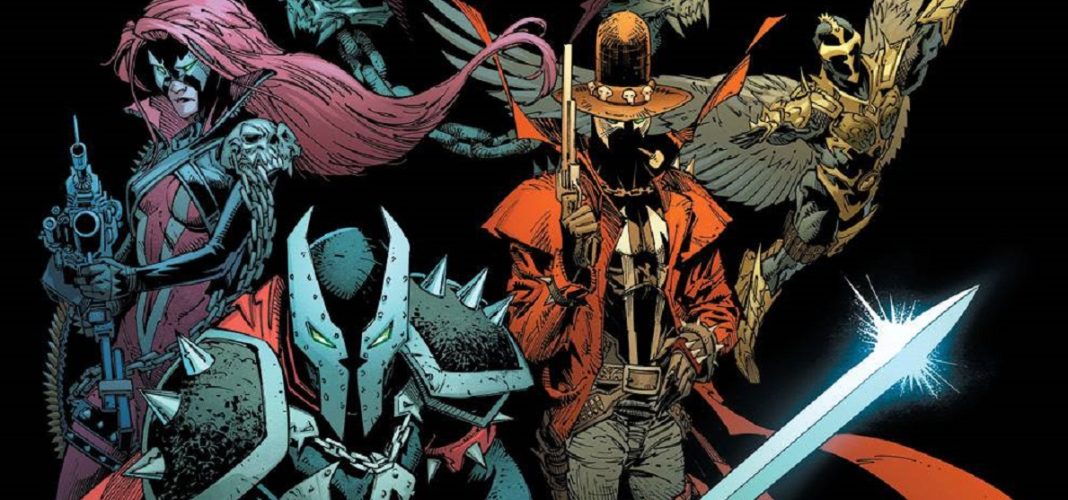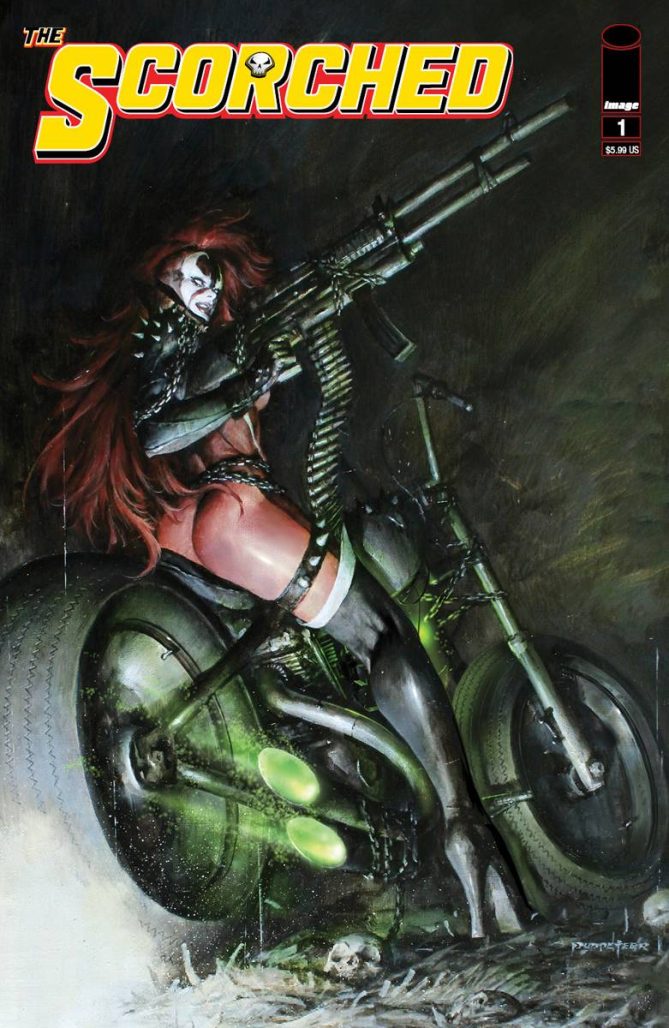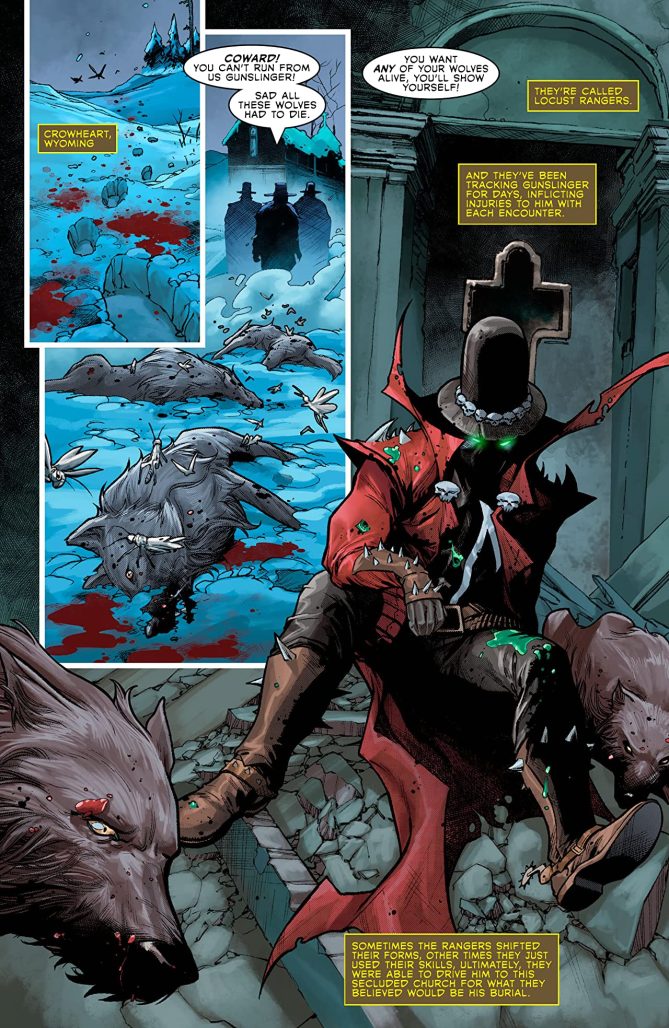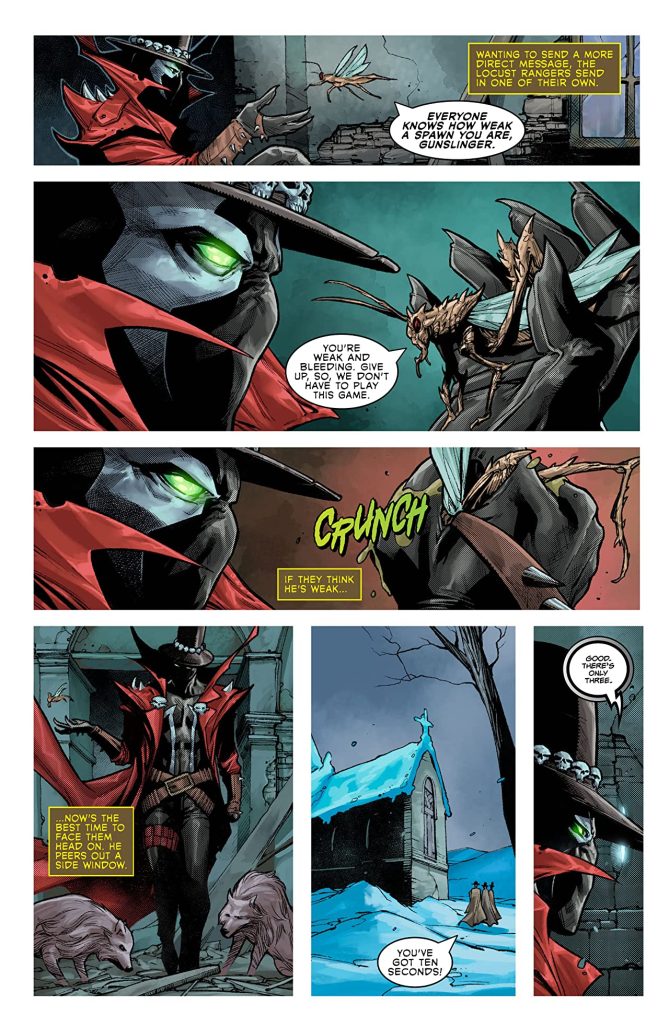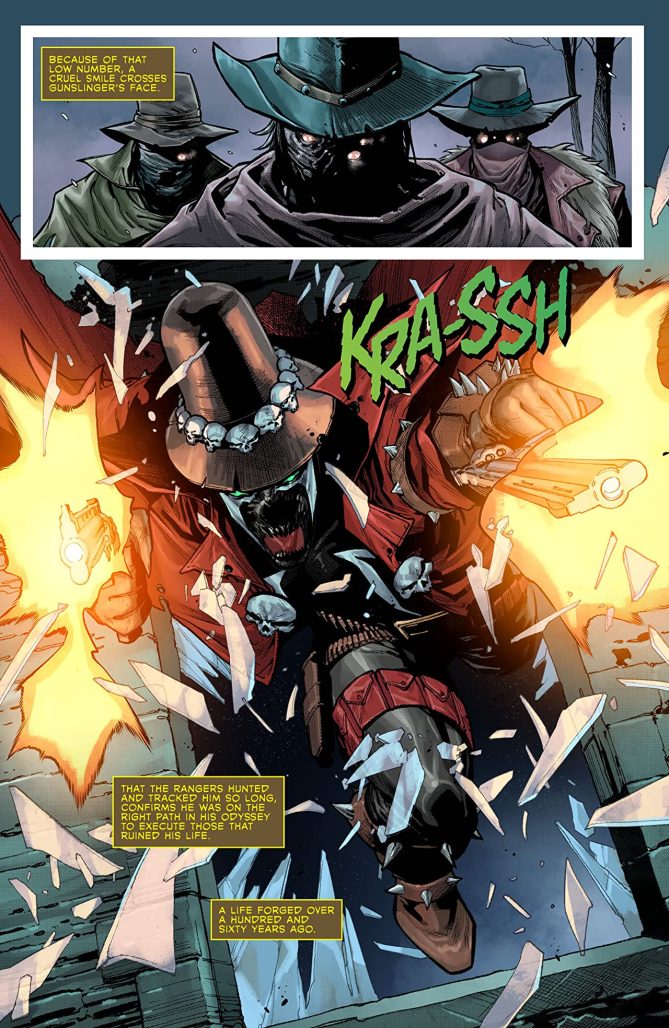This week marks the release of The Scorched #1, the latest addition to the Spawn universe. Written by Sean Lewis, with art by Stephen Segovia and Paolo Siqueira, this book has the distinction of being the first-ever ongoing team-up comic for the Spawn franchise, bringing together Spawn, Redeemer, Gunslinger Spawn, She-Spawn, and Medieval Spawn.
The Scorched makes for an even four monthly Spawn comics now, rounding out a group that includes King Spawn and Gunslinger Spawn, both of which launched in 2021. The book sold 270,000 copies to comic book stores, making it, as Image Comics touted in a recent press release, the biggest new team superhero comic in 30 years.
This all marks the biggest expansion for Spawn as a comic book brand since the character and series first arrived way back in 1992, with the character’s creator, Todd McFarlane, calling last year the Year of Spawn. In advance of the new series arriving, we spoke with McFarlane about this comic, the overall direction of Spawn, and the ongoing possibility of the character returning to the silver screen.
Zack Quaintance: First off, I wanted to ask about this being a team book. As the book points out, Hellspawns have never really banded together before. So, what makes now the right time for a Spawn team-up comic?
Todd McFarlane: It’s just part of the bigger plan I put together for 2021, which was trying to expand the universe. Obviously you can do that by giving more characters their own book, but maybe all of them aren’t worthy of a book right now. Maybe I need to build up their fanbase before giving them their own book or miniseries. The only other place then to do it is having them appear in the other monthly books, but then those books become quasi team-up books.
What I was running into with the original Spawn comic is I had all these characters and all these ideas, but the only place I could put them in was the Spawn book. That took away from him being a solo artist. Part of it was I need to create some new books, both so I can push off some of these characters and so I have another place where they can interact with each other without taking over someone else’s regular comic book. It seemed like a natural progression with all the other books we were putting together for the Year of Spawn.
Quaintance: Last time you talked to us, you mentioned that the lineup would rotate like a sports team. Now with The Scorched #1 out, do you care to tease any new plans or characters for this book?
McFarlane: We’ve introduced a couple that will be in the background and there are others still yet to be discovered. We’d like to see if by year’s end Haunt is part of that group, and also to see if this newer character that came up in Spawn #300 called The Reaper, see if I need him. He’s got connections to Heaven to balance the scales a little bit, but we also need characters that are neither angelic nor demonic; they’re just superheroes. I need to start populating the world with non-Spawn-esque type characters just to make it well-rounded.
The other thing too is it depends on why they’re leaving. Characters are leaving the book for two reasons: 1. because somebody else is in higher demand; and the other one is for the exact opposite reason, that they got so popular I want to go give them their own book in some format, whether that’s ongoing or not. The story I come up with may not be conducive to them being part of a team.
I think all team books are no different than sports teams or like going to an Avengers movie. People are going to rank their favorites of who they think is the coolest or whose not. They’re going to ask the question, ‘hey, why isn’t this character going in?’ It’s what we do as fans. I’m sure there will be some of that speculation as the book hopefully gains popularity.
I want to also have the writer at any given time — in this case, it’s Sean Lewis, who is doing a wonderful job — to also give a reason and rationale for why someone is on a team, other than they’re popular and we like them. Why is that character part of this squad? I want that and those answers to be part of the equation, although it doesn’t have to be heavy-handed.
The other part of it is, now that they’re on the team, what is their relationship to everybody? Everybody doesn’t have to like each other or dislike each other. If you consider it to be sort of a family or a locker room — I’ve played plenty of sports and when we stepped between the lines every one of us was focused on the exact same goal. In comic book terms that would be beating up the bad guy, saving the world, but once you get back into the locker room, you still have personalities. It’s not like you like all your teammates the same. You played for a common goal and left the rest of it aside. I think all of that should be in team books.
Quaintance: You mention working with Sean Lewis. I like his work a lot and I was curious what your collaboration was like?
McFarlane: At the beginning it was a lot, probably to the point that Sean was a little overwhelmed because I was trying to download him with 300 issues of Spawn plus all the backstory, mythology, and all that other stuff. Not that I want him to maintain it. That’s not necessary, but just so he was aware of it so if when he came up with storylines, if he was stepping on any continuity toes, than those had to be addressed at least a little bit. If for the last 100 issues, Spawn and another character were best buddies — I’m making it up now — and their story is that Spawn and his best buddy are now mortal enemies, as long as we acknowledge somewhere they used to be best buddies, because that’s what the landscape is now when Sean takes over.
It’s like saying, here’s where all the chess pieces are, now you go figure out the strategy. Tell me what you think is a compelling story, and I’ll tell you if any of those components are butting up against continuity. If they are, we just need to quickly adjust — maybe not quickly, maybe in a significant way — but we just need to adjust things so you can get your story moving. We were having a conversation where he was saying wouldn’t it be cool if character A married character B. I said, that would be so cool, except character A is already married. I’m not averse to character A and B getting married, it’s just that character A is already married so they have to get a divorce or their spouse has to die.
Or we have to ask what if character B marries someone who isn’t married? Does it have to be character A? We just have these ongoing conversations about how set in stone are any of these ideas. Those are some of the goofy conversations that Sean and now Rory McConville – who’s writing the Spawn comic book with myself — and my editor, Thomas Healy, get on the phone and chat about. It’s good because up until recently there was only [one] person who was fluent in the Spawn universe and that was me, sort of the downside of me being a one-man show. I’ll be bringing on more people, and hopefully they’ll be coming up with stuff that’s way cooler than I could ever imagine.
Quaintance: How has that been, expanding the team working with Spawn after all these years? Has it been reinvigorating at all?
McFarlane: It has for me. Time will tell, but I think it’s healthy for anything to get a new pair of eyes on an idea. You have people coming in with no biases to some extent, and you could argue letting one person (i.e. myself) write and edit themselves, you can create blind spots that you’re not aware of, both creatively and the way you see characters moving. Somebody who will not treat it as precious as I may have comes in and says, hey wouldn’t it be cool if this happens and here’s the reason and rationale behind it. Then you talk it out.
I keep telling them, forget what I’m doing. Look at all the characters and fill in the gaps, or build upon some interesting corners that already exist. Don’t worry about repetition.
Quaintance: I wanted to ask about last year being branded as the Year of Spawn. Sales were really strong, and I was wondering if there were any major takeaways for you. With last year being the first major expansion of Spawn, were there any surprises?
McFarlane: It worked better than I expected. I had a game plan and I adhered to it. It began you could argue right before issue #300. I knew what the story was going to be in #300, and I had a moment where I could create this rip in time and open up the floodgates. If I was going to open the gates and do nothing about it because I only had the one book, it might be a little frustrating for readers. I decided I was going to let it percolate for about a year, and then start expanding.
If you look at the covers that Jerome Opeña penciled and I inked on issues #300 and #301, that was my big giant not-too-subtle hint as to what was going to be coming down the pipeline. Even the smaller sub stories were in #300 and #301. You could see the introduction of some new characters. I said okay, let’s do this official. If I’m going to do it — I’ve been thinking about it for a decade — let’s have a game plan. So, the game plan was exactly what I did. Come out with the event book, Spawn Universe. Follow that up with King Spawn, because he’s the known quantity. Go past him with Gunslinger, who was this popular new character, and then mash some of these characters together that people know and have known over the years, and see how it goes.
If you’d have asked me at the beginning, I’d have said Spawn Universe was going to come out, King Spawn was going to do better than Spawn Universe, and I thought Gunslinger and The Scorched would be somewhere in between, with Gunslinger being a little higher in sales. That’s exactly how it all ended up. The surprise was if you were to put a number to any of those, my number would have been way way smaller than what we ended up getting because at the time of the planning, the target for everybody was a book hitting 100,000 in any given book, whether it was an event book #1 or whatever Marvel or DC book; 100,000 was sort of the goal for any book to hit.
When Spawn Universe came out with 220,000 to 230,000, we now see in hindsight that it was the worst of the bunch. I wouldn’t have guessed those numbers. The other extreme was the 500,000 we sold of King Spawn. The rankings and popularity of it all worked the way I thought; it just went at a higher clip. But! Let’s be cautious here. Those are all #1s.
Launching issue #1s, of course, you’re going to have some level of success. The question is where are issues #6, #8, #12. Those are the tells on whether you have something that’s going to last. Not with issue #1 or even issues #2 and #3. Talk to me a year from now. Have we sustained the level of the book? The goal now is can I get all four of those books to average around 50,000 copies if you take all four and divide it by four. If the answer is yes, that would be a phenomenal feat, considering not too long ago, pre-pandemic, Image Comics only had one book selling over 50,000, and that was The Walking Dead.
Spawn #300 surpassed that mark, but once Walking Dead went away, there was only one book surpassing that number. Can we go from one to four within one brand? And we’re not also doing it with things like Department of Truth, Nocterra, Crossover, and Saga. What was a hard number to get — we had two or three books launch at over 50,000 in the previous 11 years — now in the last two years Image Comics have had many more. Hopefully my four Spawn titles will retain a sales bubble that two or three years ago none of us could have imagined. It’s not a reflection of what I’m doing personally on Spawn, it’s just a reflection on the growth of the comics industry as a whole.
Quaintance: Last question, is there anything new happening around another Spawn movie?
McFarlane: It’s the same. Either first half of this year some big news is going to drop, or I’m going to go back to the original plan, which is to shoot it for $12 million and do it all on my own. During the pandemic it seemed like the only movies making money were superhero movies. It just reinforced what everyone was already thinking of doing in the first place.
The bigger question is are we talking about Spawn the movie or are we talking about Spawn the brand. Those are two different conversations and I don’t think I can sell Spawn the movie and then ask about the brand second, because the movie will be gone. I need to ask the big question to start with. I need to ask, what am I selling? Spawn is a big word right now. It’s not just tied to one book and one character.
The first issue of The Scorched is available in stores and digitally now.


